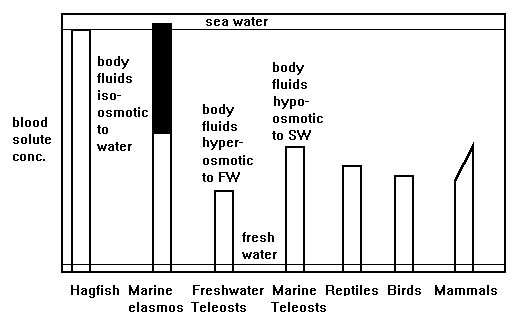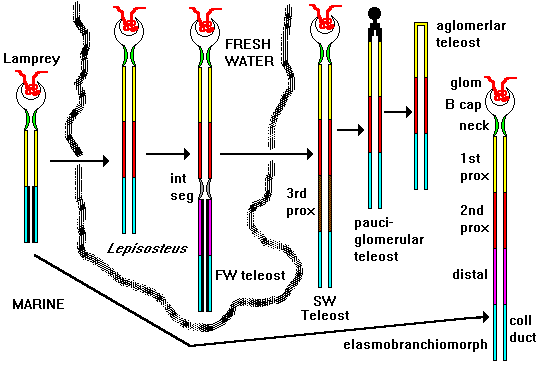|
|
Ion-Osmoregulation and Excretion
All fish have large areas of permeable epithelia in contact with the water. Water is the major solvent of cells and extracellular fluids of all organisms. It is the medium in which macromolecules must function. Macromolecular machinery of cells requires an hospitable micromolecular environment to maintain function, in which water and ion composition are major contributors.
Waste products "pollute the factory". Maintaining an hospitable micromolecular environment for macromolecules requires wastes be removed from the vicinity of the cellular machinery, and usually removed from the animal.
The energy costs of ion-osmo-regulation are high, the major cost being in ion transport.
Ions and water move down their electro-chemical gradients, from regions of higher charge and/or high concentration. Water is not charged, so it moves strictly along its concentration gradient. The major biological mechanism for moving ions is by active transport and/or locally setting up favorable electrical gradients, while the resultant ionic concentration gradients are used to move water. Water is not actively transported.
|
|

Some agnathan groups invaded FW in the upper Silurian, about 350 million years BP. Radiation of bony fishes occurred in FW, but some actinopterygians returned to SW. Some lost glomeruli, and some of these then returned to FW. A descendant of the FW agnathans may have returned to SW giving rise to the elasmobranchs, some of which radiated into FW after adapting to SW. However, it is unclear whether cartilaginous fishes evolved in fresh or seawater.
Summary of Problems:
|
ammonia |
urea |
|
ammoniotelic |
ureotelic |
|
very soluble in water. |
soluble in water. |
|
diffuses rapidly. |
|
|
300-500 ml water/ gm nitrogen. |
50 ml water/ gm nitrogen. |
|
1 mole of N per mole of ammonia - ammonium. |
2 mole of N per mole of urea. |
|
lowest energy cost per mole. |
|
|
no carbon loss. |
1 mole of carbon lost with 2 moles of nitrogen. |
|
least energy loss in potential energy of metabolizable covalent bonds in excreta. |
All fish couple excretion, pH regulation and other ion exchanges. Thus fish have Na+/NH4+/H+ and Cl-/HCO3- exchangers. All fishes have to regulate NH4+ and H+ exchange, whether in SW or FW. These exchangers are present in marine fish, for example, where their role in pH regulation and excretion exacerbate the NaCl influx. These exchangers become especially important in FW in taking up ions to make up for the diffusional loss.

Key: glom = glomerulus, B cap = Bowmanís capsule, neck = neck, 1st prox = 1st proximal tubule, 2nd prox = 2nd proximal tubule, 3rd prox = 3 rd proximal tubule, int seg = Intermediate segment, distal = Distal tubule, coll duct = Collecting duct
In general, the kidneys serve to excrete water (elasmobranchs and FW teleosts) and bivalent ion, and to conserve water (SW teleosts) through isosmotic water uptake from tubules. Monovalent NaCl is regulated extrarenally. Water uptake in SW teleosts is extrarenal.
Blood is isosmotic with SW, but ion concentrations differ. Regulate water and ions.
More like teleosts.
Gain water and lose ions. Ions are replenished from food and by extrarenal uptake. Kidneys excrete excess water, and minimize ion loss.
Lose water and gain ions. Bivalent ions are excreted in the kidney with a little wtaer as possible. Water replenished by drinking SW with isosmotic water uptake in the intestine. The resultant monovalent ion load and ions gained by diffusion are excreted extrarenally by the gills.
Filtrate produced via secretion of ions into the lumen.
Blood slightly hyperosmotic to SW due to retention of urea and TMAO. Gain water and ions, lose urea and TMAO. The kidney excretes bivalent ions and excess water, retaining urea and TMAO. Monovalent ions are excreted extrarenally at the rectal gland. TMAO and urea losses made up by synthesis and/or from food.
|
|